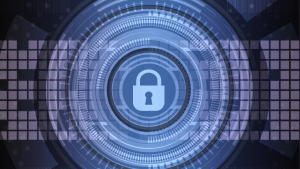Retaining ownership over intellectual properties is key to long-term success with video content.

To build a successful business, digital content publishers need to protect their intellectual property rights.
Whether you run a multi-million-dollar enterprise or a small e-learning brand, digital piracy is a significant threat to your long-term earning power.
Digital rights management (DRM) protection is a collection of security technologies that protect content from unauthorized access and distribution.
DRM protection tools allow publishers and content creators to control who can access digital assets, and what users can do with those assets as well.
Why do you need DRM Protection for your digital assets?
Enterprise video platforms use DRM protection to prevent users from handling digital assets in unauthorized ways.
DRM technology is what keeps Amazon Kindle users from simply copying books and emailing them to their friends for free. It prevents Spotify users from downloading songs and sending them to non-subscribers.
Since the internet enables free, instant communication for almost everyone, valuable digital assets need to be secured.
If you plan on making a living creating digital content – whether in text, audio, or video format – you cannot reasonably compete with people who make your content available for free.
Digital rights management enables content creators to protect valuable content and monetize their content effectively. This makes DRM a powerful tool for online educators, digital publishers, and creatives from every industry
If you rely on monetizing content to drive value by educating or entertaining users in some way, then you need to protect your investment against digital piracy.
Digital Piracy & the Importance of a Secure Video Hosting Platform
Digital piracy has been a problem for digital content creators since the early days of the Internet – and today is no different. Finding ways to mitigate the costs of digital piracy remains one of the main challenges content creators face today.

Digital pirates use hacking techniques to distribute valuable digital content to everyday users for free. But they don’t just cut into the profits of Hollywood movie producers and streaming companies – they also cut independent content creators out of hard-earned profits as well.
Although digital piracy is often seen as a victimless crime, it actually plays a key role in the global cybercrime industry. It’s become common for cybercriminals to insert malware into free movies, audio, and other intellectual properties in order to launch major malware attacks.
For content creators who charge money directly to users for video content, secure video content management is a must-have.
If your video hosting platform does not know how to protect video content from unauthorized use, it’s only a matter of time before your subscription materials end up being passed between non-paying users for free, potentially spreading dangerous malware in the process.
Your video hosting platform plays a central role determining how secure your business content is.
Highly secure video platforms make it harder for unauthorized users to download and distribute copyrighted materials without the owner’s permission.
Importance of DRM-protected video hosting: How it works
DRM-protected video hosting allows publishers and content creators to establish strict rules for how users can interact with their content.
These rules are coded into the digital asset management solution that hosts the video as well as the embedded video player that viewers use to access it.
Digital rights management software helps content creators monetize their work using a variety of data protection and governance technologies.
These technologies combine to give content creators a robust system for protecting their content in four ways:
- Encryption. Video encryption ensures that valuable content is not publicly accessible. Instead, users must present a key that unlocks that content and allows it to be viewed. This key may be a password, but it doesn’t have to be.
- Governance. Data governance allows content creators to define a decryption key that is based on a certain set of conditions (rather than a password). For example, viewing your content from a specific region or on a certain type of device may provide the necessary key.
- Authentication. Once the video hosting solution determines that a user meets the terms of its DRM protection, it decrypts the content so the user can view it. The authentication process ensures that the viewer has passed all of the appropriate verifications.
- Enforcement. Every good video hosting solution must regularly check viewers’ DRM authorization to ensure they still meet the terms of the policy. This prevents users from accessing content through a trusted channel and then simply switching to a separate device or location in order to steal content.
Most DRM solutions operate through the use of encryption keys. The problem is that encryption keys are made up of digital information, which makes them easy to copy and share.
Modern video encryption technology supports encryption keys with a robust set of digital rights management technologies that prevent encryption keys from falling into the wrong hands.
How can digital rights management safeguard your online digital content?
Digital content creators and enterprises use digital rights management to protect their investment in high-impact digital assets.

If your organization plans on monetizing documents, images, audio files and videos, you need to be able to protect your investment in creating those assets using a DRM platform.
Some of the ways enterprise video platforms use DRM technology to protect content creators’ intellectual properties include:
- Restricting users from saving or downloading content. One of the most important ways DRM protection keeps content safe is by preventing users from downloading, sharing, or distributing content on their own. A strong DRM video encryption engine keeps video content in the video player, and prevents users from downloading the video file directly through their browser.
- Restricting users from accessing content from certain locations. If there is no justifiable reason why viewers from foreign countries would need access to your content, you can exclude users from those territories from accessing it. This helps narrow down the list of people who can gain access to your videos.
- Setting expiry dates on content. Some types of video content are no longer useful after a certain time frame, yet may still contain sensitive information. Video content management solutions that can automatically restrict access to expired videos help reduce the risk of unauthorized users gaining access.
- Locking content against specific IP addresses or devices. If you know that authorized viewers will access your content from specific IP addresses or devices, you can whitelist those devices and prevent others from accessing the content. This approach is ideal for video content destined for a small, well-defined audience.
- Watermarking content for digital forensics. This type of video encryption places digital watermarks in video content, making them immediately identifiable to authorities and streaming companies. This can help prevent your subscriber-only content from ending up on free video hosting platforms.
Without a DRM video hosting solution in place, there is nothing to stop a single viewer from downloading your video content and posting it for free on social media.
Even the world’s most popular video platforms often fail to keep copyrighted material off their networks. If your content is easy to download and share, it’s a fair bet that some unscrupulous users will do exactly that.
DRM protection makes it hard – but not impossible – for users to pirate protected content.
By eliminating the easiest ways to steal protected content, pirates are forced to spend considerable time and energy trying to gain illicit access to copyrighted materials.
There is no silver bullet solution that can prevent piracy entirely, but making the process difficult has been proven to work.
Statistics show that digital pirates, hackers, and cybercriminals are actually quite lazy – they prefer to reach for low-hanging fruit than expend valuable resources trying to bypass a robust security system like DRM protection.
Significance of DRM Protection for Businesses
DRM protection enables content creators to secure their investment, reliably generate valuable content, and build a successful enterprise hosting environment.
By confronting digital piracy and establishing robust security policies that protect your data, you can make sure your users only access the content they have paid for – after they pay for it.
In the world of cybersecurity, there is always a balance between security and usability. The very best DRM video hosting platforms adopt an approach that minimizes the usability impact of their security technologies.
This means that their security policies work in the background, preventing unauthorized access while letting authorized users through in a frictionless, transparent way.
Content creators that invest in a usability-oriented DRM protection solution are able to improve the user experience for their viewers without compromising their security policy. This is a competitive advantage that any content creator will need to thrive in today’s digital piracy landscape.
Cincopa is a digital asset management solution that provides secure video hosting to content creators and enterprise publishers alike. Find out how our DRM protection technology can help you secure your content against piracy and theft.









